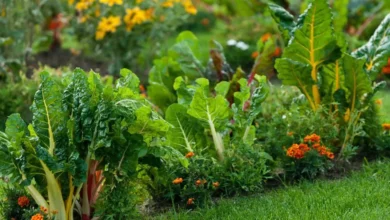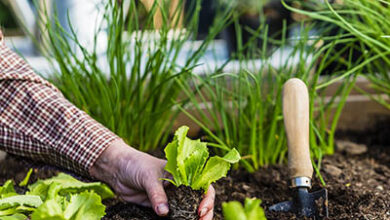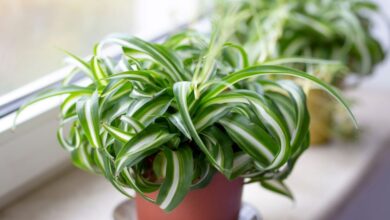Specifications
- Sun exposure: Full sun to part shade
- Water needs: Moderate
- Height: Up to 3 feet
- Flowers: White or pink
- Season of interest: Autumn
- Special note: It requires infrequent repotting since it likes its rootbound.
- USDA hardiness zone: 10 to 11
Crassula Ovata’s ‘Hobbit’ is often mistaken for Gollum Jade, but the difference between these two Jade Plant varieties lies in the shape of their leaves.
Crassula ovata Hobbit are popular types of succulent plants. People grow them as bonsai plants.
You may also recognize them by their other names – Finger Jade, Organ Pipe Jade, or Hobbit Fingers.
Due to their similar appearances, like the Crassula ovata Gollum variety, many people often confuse them for one another.
Though Crassula ovata Hobbit and Gollum have a similar look, you can easily differentiate each other by identifying the trumpet-shaped and tubular leaves.
This variety of Crassula ovata may reach 3-feet tall, and the leaves may grow 2-inches long.
During their blooming period, they produce small, star-shaped flowers that have pinkish or white colors.
They prefer growing under bright sun and even grow well in low humidity – Crassula plants, like other succulents, can propagate this species by stem cuttings.
Hobbit Jade has pipe-like leaves with a slight curl and red tips – some may say it resembles sea corals.
You can grow it indoors or in the garden, and if you provide it with the ideal growing conditions, you will be rewarded with starry flowers.
Hobbit jade is categorized as a desert plant, so fertilizing it regularly may be too much for them.
When you do fertilize, dilute the plant food in water but never during winter when it is in a state of dormancy.
Crassula Ovata ‘Ripple Jade’

Specifications
- Sun exposure: Full sun to part shade
- Water needs: Moderate
- Height: 3 to 4 feet
- Flowers: White
- Season of interest: Spring
- Special note: This Jade Plant type rarely flowers
- USDA hardiness zone: 9 to 11
Crassula Ovata’ Ripple Jade’ is easily recognizable by its thin and wavy leaves.
Ripple Jade, also called Curly Jade has circular, but twisted leaves which are mainly green with touches of faded blue.
Each leaf has purplish or dark brown edges, and the thick foliage is evergreen.
This variety is deficient maintenance and can be cold-hardy in zone 10.
Ripple Jade is a robust grower but will appreciate protection from hard frost.
The plant is extremely drought-tolerant, and a good indicator of proper watering is needed are the leaves – if it has been without water for too long, the leaves will wrinkle and look far from normal.
This Jade Plant type responds well to pruning, and it will prevent the plant from becoming leggy if there is a light deficiency.
Crassula Ovata ‘Undulata’

Specifications
- Sun exposure: Full sun to part shade
- Water needs: Occasional
- Height: Up to 1.5 feet
- Flowers: Pinkish white
- Season of interest: Summer
- Special note: Fertilize every two weeks during the growing season but not during winter.
- USDA hardiness zone: 9 to 11
Also known as Jitter Jade, Crassula Ovata ‘Undulata’ is different from other Jade Plant varieties because it appears curly instead of the conventional thick and elongated leaves.
The Crassula Ovata ‘Undulata’ has waxy, wavy leaves that grow very dense but at a slow pace.
The plant can be grown outdoors in containers, as a compact groundcover, or inside as a houseplant.
Jitter Jade, a natural desert plant, enjoys bright sunlight but can tolerate light shade, although it will not look its best.
Dark edges on the leaves start appearing when cooler months enter.
Jitter Jade responds well to pruning, but you may delay the trimming so it can spread to look like a mini Jade Plant tree.
Crassula Ovata ‘Minima’

Specifications
- Sun exposure: Full sun to partial sun
- Water needs: Occasional
- Height: Up to 2.5 feet
- Flowers: Coral pink
- Season of interest: Early spring to late summer
- Special note: Propagation can be achieved by using a leaf; dry it and leave it on top of some soil – soon roots will form from the leaf.
- USDA hardiness zone: 10 to 11
Crassula Ovata’ Minima’ is referred to as Baby Jade because of its small size compared to other Jade Plant varieties.
Baby Jade starts green but red edges appear on the leaves as the plant matures. The thick, fleshy leaves appear from woody branches.
It is a pretty shrub you can use as a feature pot plant or add interest to a rock garden – it makes a beautiful groundcover.
As a true Crassula, it is hardy and compact and can tolerate some dryness.
Their archenemy is overwatering, and well-draining soil is a must. Showy flowers in pink corals will bloom in ideal conditions.
Crassula Ovata ‘Lemon & Lime’

Specifications
- Sun exposure: Partial sun to full sun
- Water needs: Occasional
- Height: 1 to 4 feet
- Flowers: White
- Season of interest: Late winter to early spring
- Special note: Fire and deer resistant
- USDA hardiness zone: 9 to 11
Crassula Ovata’ Lemon & Lime’ is the variegated cultivar of the common Jade plant.
It has the ‘Tricolor’ Jade moniker because of the green leaves bordered with creamy white and tipped with a pink tinge.
Each leaf is shaped like a spoon, and this Jade Plant variety flowers starry white blooms that attract useful insects.
The trunk is stout, suitable for containers, but it is also beautiful as an outdoor specimen.
Crassula Ovata’ Lemon & Lime’ has good heat tolerance and will survive prolonged dry spells.
Although they appreciate regular misting, water requirements can be on the side of neglect. It is succulent, so expect stored water in the leaves.
Crassula Ovata ‘Hummel’s Sunset’

Specifications
- Sun exposure: Full sun to partial shade
- Water needs: Occasional
- Height: 1 to 3 feet
- Flowers: White to pale pink
- Season of interest: Fall to spring
- Special note: Grows slower than Crassula Ovata
- USDA hardiness zone: 9 to 12
Award-winning Crassula Ovata’ Hummel’s Sunset’ or Golden Jade is one of the Jade Plant varieties that received the Royal Horticultural Society’s Award of Garden Merit.
The Golden Jade has evergreen leaves, which like the mother variety, are thick, fleshy, and round.
But it is not a one-color leaf but actually has a dash of golden-yellow and red edges.
The intensity of the red outline deepens during colder months.
This Jade Plant blooms starry white flowers in a cluster.
Outdoors, it is one of the showier Crassulas. The Golden Jade tree has a very mild tolerance against frost.
Crassula Ovata ‘Harbour Lights’

Specifications
- Sun exposure: Full sun
- Water needs: Occasional
- Height: Up to 2 feet
- Flowers: Pinkish white
- Season of interest: Late autumn to early winter
- Special note: The plant is not winter hardy and temperature should not drop below 7 for to survive
- USDA hardiness zone: 10 to 11
Give your house or garden some spice with this cultivar’s distinct red color.
Crassula Ovata’ Harbour Lights’ is a Jade Plant variety that grows green but turns sunset red when cooler months approach.
The trunk is stubby, with small flowers growing on the tips in ideal conditions.
The plant is suitable for seaside planting since it can tolerate sandy soil.
The leaves are relatively small, but the plant grows dense enough to spread like a bonsai.
Crassula Ovata’ Harbour Lights’ leaves’ store water to use in times of drought.
Crassula Arborescens
Specifications
- Sun exposure: Full sun to light shade
- Water needs: Occasional
- Height: 4-5 feet
- Flowers: White or dark pink
- Season of interest: Spring or summer
- Special note: Brown spots on leaves indicate insufficient watering
- USDA hardiness zone: 9 to 12
Crassula Arborescens or Silver Jade is a succulent that needs no trimming.
This Crassula type has a balanced proportion of stubby trunk and grey-green leaves.
The foliage has an almost round shape with red edges that intensify when kept in full sun.
It is rarely cultivated for its flowers, but they are clusters of tiny star-shaped inflorescences when they appear.
Crassula Arborescens or Silver Jade is a very forgiving plant.
It can take drought and poor soil types, but it has to have fast drainage.
You should always have a well-draining pot with drainage holes.
Overwatering is the main culprit for the unsuccessful growth of this succulent.
Silver Jade looks best included in a rock garden but also makes a stunning indoor plant.
Every leaf is covered with fine small greyish hairs that provide the overall silvery look.
One variety is Crassula Arborescens, Blue Hale, which has blue-green foliage.
It is about a foot tall with large discs of leaves – 4 inches each.
Crassula Barbata
You can easily identify this plant in a nursery or garden.
This plant has a beard-like structure. Unlike the other Crassula plants, this variety is either biennial or annual.
The succulent may grow as tall as 1-foot during its blooming period.
The leaves can grow 5-centimeters long and 4-centimeters wide and contain white, long, spreading hairs.
You can easily take care of this Crassula variety. It requires bright indirect light.
If you grow it indoors, then try keeping it near a south-facing window. Inadequate sunlight can inhibit its growth.
The potting mix should be neutral and have an improved drainage system. You may add coco coir to improve the quality of the soil and its drainage.
It cannot tolerate excess water.
Crassula Barklyi
Crassula barklyi has a strange appearance. It resembles a rattlesnake tail. It is widely grown in the area of the Northern Cape of South Africa.
You will find this species in rocky or graveled areas. This perennial succulent has an erect stem that looks similar to the rattlesnake tail.
It grows very slowly and may reach up to 90-millimeters tall.
This Crassula plant needs strong sunlight to grow.
You may either plant it in a sunny location in your garden or place it near the south-facing window.
You should use a rocky blend formulated potting mix for growing this variety indoors. Never overwater it, as excess water can cause root rot.




